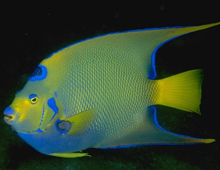Description: Queen angelfish are vibrantly colored with shades of blue and yellow. Their compressed body is blue to blue-green with yellow on the scales’ rims. Their blunt, round head has a dark blue spot on the forehead that resembles a “crown”, thus their common name. They have a small mouth with dark blue lips. Some of their fins are yellow while the others are blue. The pectoral and ventral fins, along with the tail, are yellow. The long dorsal fin and anal fins are blue. Juveniles have a darker body with vertical light bars that disappear as they age. Their coloration helps them to blend in with the reefs where they live.
Size: Adult Queen angelfish reach an average length of 17.6 inches (45 cm); males are usually larger than females.
Behavior: Adult fish are often seen in pairs and sometimes even solitary. They use their pectoral fins for swimming. Their body shape enables them to dart easily in and out of coral to escape predators and find their prey.
Diet: Their main sources of food are sponges and coral, however they will also eat algae, plankton and marine invertebrates. Juveniles of this species form cleaning stations and feed on the parasites of larger fish.
Senses: Angelfish have a lateral line (series of fluid-filled ducts) that sense pressure or vibrations caused by the motion of approaching predator or prey. They also have binocular vision.
Communication: Changes in their coloration, especially during mating, is one way these fish communicate with one another. A male will display his pectoral fins, flicking them outward to entice a female to mate with him.
Reproduction: After the courtship ritual performed by the male, the male and female rise up in the water column with their bellies close together releasing large amounts of eggs (the female can release as many as 25,000-75,000 eggs) and sperm into the water where fertilization takes place. The buoyant, transparent fertilized eggs float for about 15 to 20 hours before hatching into larvae. Over the next 48 hours, the yolk sack is absorbed and once absorbed, the larvae feed on plankton and grow rapidly. About three to four weeks later they settle on the bottom of the reef as juveniles.
Habitat/range: These non-migratory fish are found on coral and rocky reefs in the western Atlantic Ocean, the Gulf of Mexico and the Caribbean.
Status: Listed as Least Concern on IUCN Red List.



